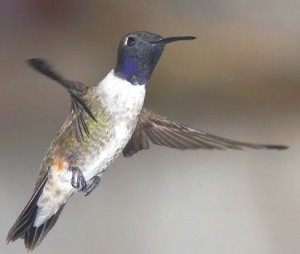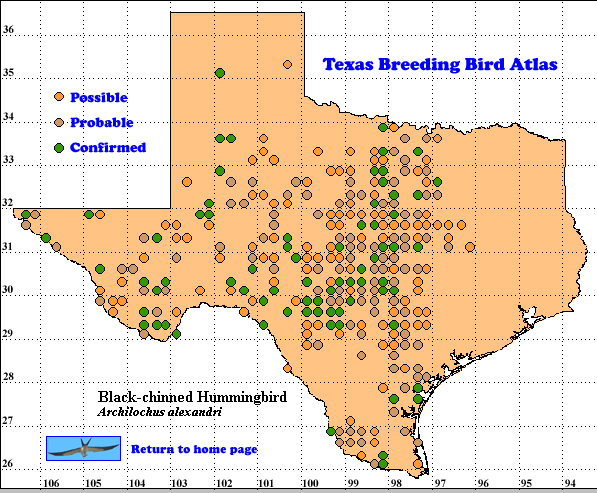Black-chinned Hummingbirds are widespread in the western United States and adjoining southwest Canada and northern Mexico. This species is closely related to the Ruby-throated Hummingbird ( A. colubris) of eastern North America and the northern Great Plains. The breeding ranges of these two species overlaps only in Texas between the 96th and 98th meridians (Am. Ornithol. Union 1998, Baltosser and Russell 2000, TBBA data).
DISTRIBUTION. During the 1987-1992 field work seasons of the TBBA project, volunteers found most breeding evidence for Black-chinned Hummingbirds west or just east of the 97th meridian. The densest concentration of breeding sites was found along the boundary between the eastern Rolling Plains, Edwards Plateau and South Texas Brush Country and the western edge of the Post Oak Savannah and Blackland Prairie regions (see the region map in Lockwood and Freeman [2004]). No breeding sites were found east of the 96th meridian and only 2 north of the 34th parallel.
The distribution map derived from 1994-2003 North American Breeding Bird Survey (BBS) data is similar to the TBBA map except for an area in the northwest corner of the Panhandle. The area of highest relative abundance in Texas with route averages of 3-10 Black-chins per year is similar to the area of densest breeding sites on the TBBA map. The map and data from 3 Texas routes with the highest averages (2.7-4.4) in the North American BBS in Callahan, Berth and Kendall counties, show Texas has the highest abundances of this hummingbird in North America (Price et al. 1995, Sauer et al. 2007).
Outside Texas Black-chinned Hummingbirds breed in suitable habitat from British Columbia, Washington, Oregon, California and northern Baja California east to extreme western Montana, southwest Wyoming, Colorado, Oklahoma and northern Mexico. This species winters in northeast and western Mexico (Howell and Webb 1995, Boyle 1998, Baltosser and Russell 2000, Patti 2004, Wahl 2005, Wise-Gervais 2005, Sauer et a;. 2007).
SEASONAL OCCURRENCE. Most Black- chinned Hummingbirds arrive in Texas between mid-March and early May to breed from late March to mid-August, based on egg dates from April 4 to July 21 and young in nests as late as August 12. Most south-bound migrants depart from mid-July to mid-October, with a few lingering until December (Oberholser 1974).
BREEDING HABITAT. Most Black-chinned Hummingbirds breed in Texas from 120 to 2650 m (400-8750 ft) in habitats ranging from agave-cactus desert to semi-humid juniper-live oak (Oberholser 1974). In Arizona with habitats most comparable to west Texas, atlasers found these hummingbirds breeding in Sonoran Desert woodland and riparian habitats (21%), human-altered habitats (15%) and cottonwood-willow (14%; Wise-Gervais 2005). In both Arizona (16%) and Colorado (34%) pinyon-juniper is an important habitat, with deciduous riparian (23%) and rural/urban habitats (16%) also important in the later state (Boyle 1998). In Texas the narrow overlap zone between this hummingbird and the closely related Ruby-throated Hummingbird is probably climate and habitat related.
Nests are built by the female of plant down fashioned into a neat, flexible cup and bound together and to supporting twigs or branches with spider silk .A survey by B. Ortego and B. Sargent (cited by Baltosser and Russell [2000]) in Tom Green County found an average height above ground of Black-chinned Hummingbird nests of 2-4 m (7-13 ft). The outside diameter of 48 nests averaged 4.2 cm (1.6 in) and average cup depth was 2.0 cm (0.8 in). The insulating plant down keeps the eggs and young warmer on cool nights (Harrison 1979, Baltosser and Russell 2000).
In the compact nest the female lays 2 smooth, white, unmarked eggs which she incubates for 12-14 days. After hatching young birds remain in the nest for about 21 days. After departing they are fed by the female for at least a week (Baltosser and Russell 2000).
STATUS. Black-chinned Hummingbirds are common to locally abundant summer residents of their breeding range in Texas (Lockwood and Freeman 2004). The distribution of breeding sites on the TBBA map is similar to the distribution of breeding and summer symbols on the map in Oberholser (1974). BBS data from 53 routes in Texas suggest a +0.9% annual population change for the period 1980-2006, similar to the North American trend of about +0.4% for the same period (Sauer et al. 2007). The relative stability of the population and range of this hummingbird are good omens for its future in Texas.
Text by Robert C. Tweit (2008)
Literature cited.
American Ornithologists’ Union. 1998. Checklist of North American birds, 7th ed. Am, Ornithol. Union, Washington, DC.
Baltosser, W. H. and S. M. Russell. 2000. Black-chinned Hummingbird (Archilochus alexandri). In The birds of North America, No. 495 (A. Poole and F. Gill, eds.). The Birds of North America, Inc., Philadelphia, PA.
Boyle, S. 1998. Black-chinned Hummingbird (Archilochus alexandri). In Colorado breeding bird atlas, pp. 242-243 (H. E. Kingery, ed.), Colorado Bird Atlas Partnership, Denver.
Harrison, H. H. 1979. A field guide to western birds’ nests. Houghton Mifflin, Boston, MA.
Howell, S. N. G. and S. Webb. 1995. A guide to the birds of Mexico and northern Central America. Oxford University Press, New York.
Lockwood, M. W. and B. Freeman. 2004. The TOS handbook of Texas birds. Texas A&M University Press, College Station.
Oberholser, H. C. 1974. The bird life of Texas. University of Texas Press, Austin.
Patti, S. T. 2004. Black-chinned Hummingbird (Archilochus alexandri). In Oklahoma breeding bird atlas, pp. 202-203 (D. L. Reinking, ed.). University of Oklahoma Press, Norman.
Price, J., S. Droege, and A. Price. 1995. The summer atlas of North American birds. Academic Press, New York.
Sauer, J. R., J. E. Hines, and J. Fallon. 2007. The North American Breeding Bird Survey, results and analysis 1966-2006. Version 7.23.2007. USGS Patuxent Wildlife Research Center, Laurel MD < http://www.mbr-pwrc.usgs.gov/bbs>
Wahl, T. R. 2005. Black-chinned Hummingbird (Archilochus alexandri). In Birds of Washington: status and distribution, p. 229 (T. R. Wahl, B. Tweit and S. G. Mlodinow, eds.). Oregon State University Press, Corvallis.
Wise-Gervais, C. 2005. Black-chinned Hummingbird (Archilochus alexandri). In Arizona breeding bird atlas. pp. 256-257 (T. E. Corman and C. Wise-Gervais, eds.), University of New Mexico Press, Albuquerque.

